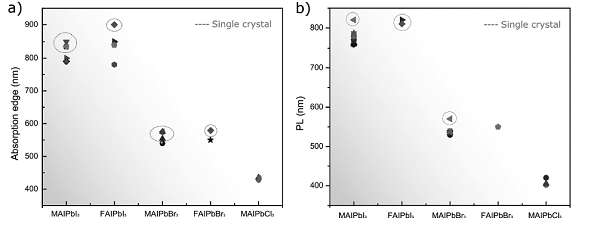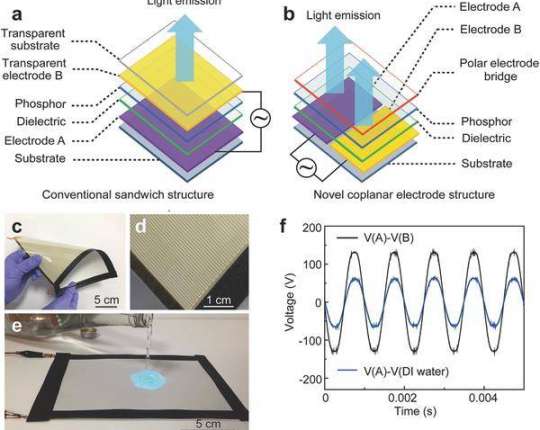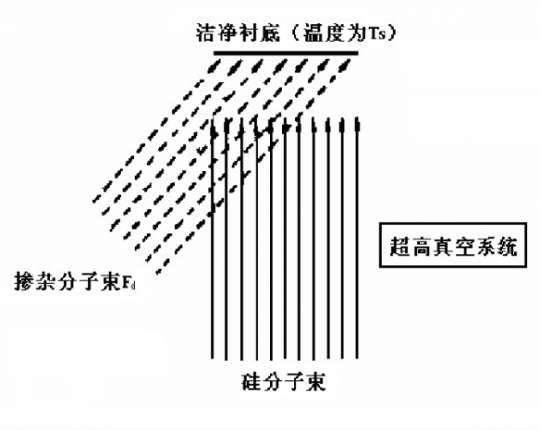1, Review of Organic Halide Perovskite – related Photoelectric PropertiesFigure 1 Spectral position and PL peakOrganic halide perovskites are widely used in optoelectronics research. Methyl ammonium and formamidine lead iodide as photovoltaics show excellent photoelectric properties and stimulate researchers’ enthusiasm for light-emitting devices and photodetectors. Recently, the University of Toronto Edward H. Sargent (Correspondent) team of organic metal halide perovskite optical and electrical properties of the material were studied. Outlines how material composition and form are associated with these attributes, and how these properties ultimately affect device performance. In addition, the team also analyzed different material properties of the perovskite materials, in particular the bandgap, mobility, diffusion length, carrier lifetime and trap density.The Electrical and Optical Properties of Organometal Halide Perovskites Relevant to Optoelectronic Performance(Adv.Mater.,2017,DOI: 10.1002/adma.201700764)2, Advanced Materials Overview: 2D optoelectronic applications of organic materials Figure 2 Several key steps in the application of two-dimensional organic materialsThe 2D material with atomic thin structure and photoelectron properties has attracted the interest of researchers in applying 2D materials to electronics and optoelectronics. In addition, as a two-dimensional material series of emerging areas, the organic nanostructure assembled into 2D form provides molecular diversity, flexibility, ease of processing, light weight, etc., for optoelectronic applications provides an exciting prospect. Recently, Tianjin University, Professor Hu Wenping, Ren Xiaochen assistant researcher (common newsletter) and others reviewed the application of organic two-dimensional materials in optoelectronic devices. Examples of materials include 2D, organic, crystalline, small molecules, polymers, self- Covalent organic skeleton. The application of 2D organic crystal fabrication and patterning technology is also discussed. Then the application of optoelectronic devices is introduced in detail, and the prospect of 2D material is briefly discussed.2D Organic Materials for Optoelectronic Applications(Adv.Mater.,2017,DOI: 10.1002/adma.201702415)3, Advanced Materials Review: 2D Ruddlesden-Popper Perovskite PhotonicsFigure 3 Schematic diagram of 3D and 2D perovskite structuresThe traditional 3D organic-inorganic halide perovskite has recently undergone unprecedented rapid development. However, their inherent instabilities in moisture, light and calories remain a key challenge before commercialization. In contrast, the emerging two-dimensional Ruddlesden-Popper perovskite has received increasing attention due to its environmental stability. However, 2D perovskite research has just started. Recently, the University of Fudan University, Liang Ziqi (Corresponding author) team published a review first introduced 2D perovskite and 3D control of a detailed comparison. And then discussed the two-dimensional perovskite organic interval cationic engineering. Next, quasi-two-dimensional perovskites between 3D and 2D perovskites were studied and compared. In addition, 2D perovskite unique exciton properties, electron-phonon coupling and polaron are also shown. Finally, a reasonable summary of the structure design, growth control and photophysics research of 2D perovskite in high performance electronic devices is presented.2D Ruddlesden–Popper Perovskites for Optoelectronics(Adv.Mater.,2017,DOI: 10.1002/adma.201703487)4, Science Advances Summary: Lead Halide Perovskite: Crystal-Liquid Binary, Phonon Glass Electronic Crystals and Great Polaron FormationFigure 4 CH3NH3PbX3 perovskite structureLead anodized perovskite has proven to be a high performance material in solar cells and light emitting devices. These materials are characterized by the expected coherent band transport of crystalline semiconductors, as well as the dielectric response and phonon dynamics of the liquid. This “crystal-liquid” duality means that lead halide perovskites belong to phonon glass electron crystals – a class of thermoelectric materials that are considered to be the most efficient. Recently, the University of Columbia Zhu Xiaoyang (communication author) team reviewed the crystal-liquid duality, the resulting dielectric response responsible for the formation and selection of carrier polaron, which causes perovskite with defect tolerance, moderate Of the carrier mobility and the combined performance of the radiation. Large polaron formation and phonon glass characteristics can also explain the significant reduction in carrier cooling rates in these materials.Lead halide perovskites: Crystal-liquid duality, phonon glass electron crystals, and large polaron formation(Sci. Adv.,2017,DOI:10.1126/sciadv.1701469)5, Progress in Polymer Science Review: Lithography of silicon-containing block copolymersFig.5 Melt phase diagram of diblock copolymerRecently, the National Tsinghua University Rong-Ming Ho (Correspondent) and others published a summary of the different methods through the preparation of ordered block copolymer (BCP) film the latest progress, focusing on the use of silicon-containing BCP as lithography applications. With the advantages of Si-containing blocks, these BCPs have smaller feature sizes due to their high resolution, large segregation intensity and high etch contrast. Considering that poly (dimethylsiloxane) (PDMS) has been extensively studied in Si-containing BCPs, the possibility of photolithography using PDCP-containing BCP has been demonstrated through previous and ongoing studies. Subsequent sections detail the main results of the DSA approach. The new trend of lithographic printing application and the application of photolithography nano – pattern using silicon – containing BCPs are also discussed. Finally, the conclusion and prospect of BCP lithography are introduced.Silicon-Containing Block Copolymers for Lithographic Applications(Prog. Polym. Sci.,2017,DOI:10.1016/j.progpolymsci.2017.10.002)6, Angewandte Chemie International Edition Overview: CH3NH3PbI3 perovskite solar cell theoretical studyFigure 6 Electronic density patternPower conversion efficiency (PCEs) of more than 22% of the hybridized perovskite perovskite solar cells (PSCs) has attracted considerable attention. Although perovskite plays an important role in the operation of PSCs, the basic theory associated with perovskite remains unresolved. Recently, Professor Xun Nining (Communication Author) of Xi’an University of Architecture and Technology, according to the first principle, evaluated the existing theory of structure and electronic properties, defects, ion diffusion and transfer current of CH3NH3PbI3 perovskite, and ion transport Influence on PSC Current – Voltage Curve Hysteresis. The moving current associated with the possible ferroelectricity is also discussed. And emphasizes the benefits, challenges and potential of perovskite for PSCs.Theoretical Treatment of CH3NH3PbI3 Perovskite Solar Cells(Angew. Chem. Int. Ed.,2017,DOI: 10.1002/anie.201702660)7, Chemical Society Reviews Overview: Reductive Batteries for Electromechanical Active Materials for Molecular EngineeringFigure 7 Molecular engineering for redox substances for sustainable RFBAs an important large energy storage system, redox batteries (RFBs) have high scalability and independent energy and power control capabilities. However, conventional RFB applications are subject to performance and limitations on high cost and environmental issues associated with the use of metal-based redox substances. Recently, the University of Texas at Austin Guihua Yu (communication author) team proposed the design of these new redox substances system molecular engineering program. The article provides a detailed synthesis strategy for modifying organometallic and organometallic redox substances in terms of solubility, oxidation-reduction potential and molecular size. And then introduced recent advances covering the reaction mechanism of the redox species classified by its molecular structure, the specific functionalization methods and electrochemical properties. Finally, the author analyzes the future development direction and challenge of this emerging research field.Molecular engineering of organic electroactive materials for redox flow batteries (Chem.Soc.Rev.,2017,DOI: 10.1039/C7CS00569E)8, Chemical Society Reviews Overview: Atomic level for energy storage and conversion Non-layered nanomaterialsFigure 8 Atomic-grade layered and non-layered nanomaterialsSince the discovery of graphene, the two-dimensional nanomaterials with large atomic thickness and large lateral dimension are highly studied because of their high specific surface area, heterogeneous electronic structure and attractive physical and chemical properties. Recently, Wulonggong University Dushi University academician (communication author) team comprehensively summed up the atomic thickness of non-layered nano-materials preparation method, studied its heterogeneous electronic structure, the introduction of electronic structure operation strategy, and outlined its energy storage and conversion Applications, with particular emphasis on lithium-ion batteries, sodium ion batteries, oxygen, CO2 reduction, CO oxidation reaction. Finally, based on the current research progress, put forward the future direction – in practical application to enhance the performance and new features to explore.Atomically thin non-layered nanomaterials for energy storage and conversion (Chem.Soc.Rev.,2017,DOI:10.1039/C7CS00418D)9, Chemical Reviews Overview: Electrochemical Applications in the Synthesis of Heterocyclic StructuresFigure 9 Mechanism of electro-induced cationic chain reactionThe heterocycle is one of the largest organic compounds to date, and the preparation and transformation of heterocyclic structures have been of great interest to organic chemistry researchers. Various heterocyclic structures are widely found in biologically active natural products, organic materials, agrochemicals and drugs. When people notice that about 70% of all drugs and agrochemicals have at least one heterocycle, people can not ignore them importance. Recently, Professor Zeng Chengchao of Beijing University of Technology (Correspondent Author) team reviewed the progress of electrochemical construction of heterocyclic compounds published by intramolecular and intermolecular cyclization since 2000.Use of Electrochemistry in the Synthesis of Heterocyclic Structures(Chem. Rev.,2017,DOI:10.1021/acs.chemrev.7b00271)
स्रोत: मेयौ कार्बाइड



